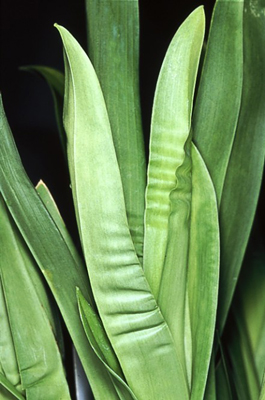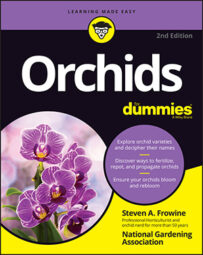Overwatering and underwatering orchids show many of the same symptoms because the effect of both practices is the same — damaged or destroyed root systems, which result in a dehydrated orchid.
The signs of dehydration include the following:
Pleated leaves on orchids like miltonias
Excessively shriveled pseudobulbs (thickened, swollen stems) of some orchids, like cattleyas
Droopy, soft, and puckered leaves on cattleyas
Yellow and wilted bottom leaves on phalaenopsis
Bud blast (in which the buds fall off instead of opening) on all orchids
 The pleated or puckered leaf of this miltonia orchid is a sign that the orchid is dehydrated.
The pleated or puckered leaf of this miltonia orchid is a sign that the orchid is dehydrated.
To evaluate whether over- or underwatering has caused these symptoms, remove the orchid from its pot. Many beginner growers are reluctant to do this, but if you're careful, removing the orchid from its pot won't disturb them and it's an absolutely necessary procedure to see what's going on with the root system.
To determine if you've under- or overwatered your orchid, follow these steps:
Turn the orchid plant, in its pot, upside-down.
Gently rap a hard object (like the handle of a gardening tool) against the pot to loosen the potting material.
Cup your hand over the surface of the pot to hold the loosened potting material as it falls out. Doing this over a workbench or a table covered with clean newspaper to hold the potting material is a nice, neat approach.
If the potting material doesn't loosen easily, use a thin knife to circle the inside of the pot to loosen the potting material from the wall of the pot.
In some situations, the potting material may be so packed into the pot that it won't come out easily.
When the orchid is removed from the pot, check out the potting material.
Is it soggy? Does it have a bad (rotting) smell? Are the roots dark and mushy? These are all signs of overwatering.
If the roots are dry and shriveled, not stiff and plump, and have no or few growing root tips, the orchid probably hasn't gotten enough water. The potting material may be too coarse, making poor contact with the roots; otherwise, you simply haven't watered the orchid frequently enough.
If the roots look okay or only slightly damaged, pot up the orchid again in fresh potting material.

